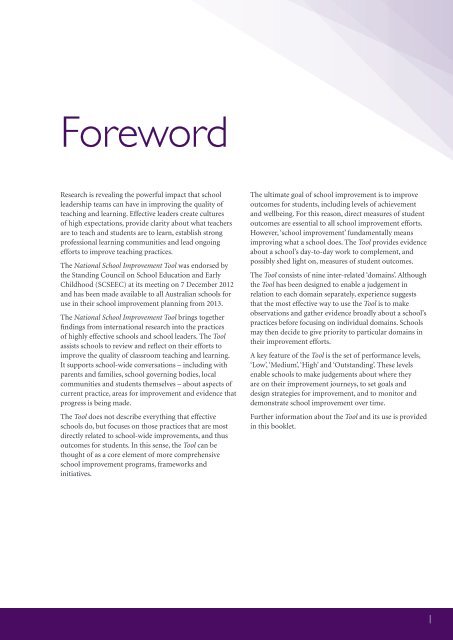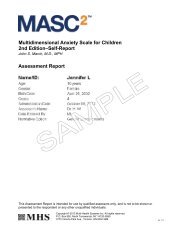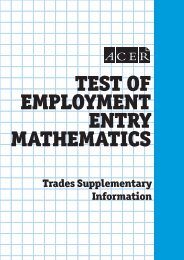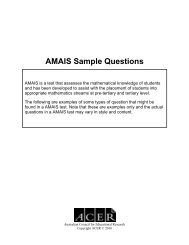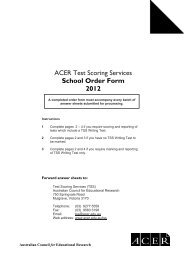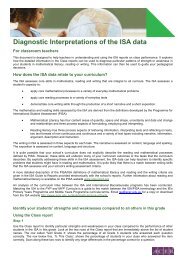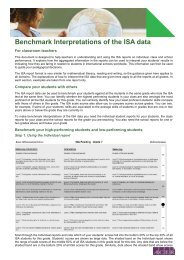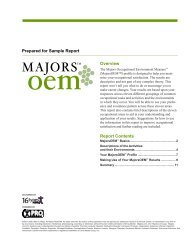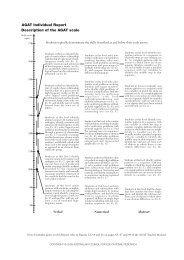National School Improvement Tool - ACER
National School Improvement Tool - ACER
National School Improvement Tool - ACER
Create successful ePaper yourself
Turn your PDF publications into a flip-book with our unique Google optimized e-Paper software.
Foreword<br />
Research is revealing the powerful impact that school<br />
leadership teams can have in improving the quality of<br />
teaching and learning. Effective leaders create cultures<br />
of high expectations, provide clarity about what teachers<br />
are to teach and students are to learn, establish strong<br />
professional learning communities and lead ongoing<br />
efforts to improve teaching practices.<br />
The <strong>National</strong> <strong>School</strong> <strong>Improvement</strong> <strong>Tool</strong> was endorsed by<br />
the Standing Council on <strong>School</strong> Education and Early<br />
Childhood (SCSEEC) at its meeting on 7 December 2012<br />
and has been made available to all Australian schools for<br />
use in their school improvement planning from 2013.<br />
The <strong>National</strong> <strong>School</strong> <strong>Improvement</strong> <strong>Tool</strong> brings together<br />
findings from international research into the practices<br />
of highly effective schools and school leaders. The <strong>Tool</strong><br />
assists schools to review and reflect on their efforts to<br />
improve the quality of classroom teaching and learning.<br />
It supports school-wide conversations – including with<br />
parents and families, school governing bodies, local<br />
communities and students themselves – about aspects of<br />
current practice, areas for improvement and evidence that<br />
progress is being made.<br />
The <strong>Tool</strong> does not describe everything that effective<br />
schools do, but focuses on those practices that are most<br />
directly related to school-wide improvements, and thus<br />
outcomes for students. In this sense, the <strong>Tool</strong> can be<br />
thought of as a core element of more comprehensive<br />
school improvement programs, frameworks and<br />
initiatives.<br />
The ultimate goal of school improvement is to improve<br />
outcomes for students, including levels of achievement<br />
and wellbeing. For this reason, direct measures of student<br />
outcomes are essential to all school improvement efforts.<br />
However, ‘school improvement’ fundamentally means<br />
improving what a school does. The <strong>Tool</strong> provides evidence<br />
about a school’s day-to-day work to complement, and<br />
possibly shed light on, measures of student outcomes.<br />
The <strong>Tool</strong> consists of nine inter-related ‘domains’. Although<br />
the <strong>Tool</strong> has been designed to enable a judgement in<br />
relation to each domain separately, experience suggests<br />
that the most effective way to use the <strong>Tool</strong> is to make<br />
observations and gather evidence broadly about a school’s<br />
practices before focusing on individual domains. <strong>School</strong>s<br />
may then decide to give priority to particular domains in<br />
their improvement efforts.<br />
A key feature of the <strong>Tool</strong> is the set of performance levels,<br />
‘Low’, ‘Medium’, ‘High’ and ‘Outstanding’. These levels<br />
enable schools to make judgements about where they<br />
are on their improvement journeys, to set goals and<br />
design strategies for improvement, and to monitor and<br />
demonstrate school improvement over time.<br />
Further information about the <strong>Tool</strong> and its use is provided<br />
in this booklet.<br />
1


